Walking through the lively streets of Istanbul, sipping Turkish tea by the Bosphorus, or watching the spiritual whirling dervishes in Konya, you quickly see that Turkish culture is not a single tradition – it’s a living mosaic. In my own travels and studies across Turkey, I’ve seen how ancient Anatolian customs, the grandeur of the Ottoman Empire, and modern European energy blend into something truly unique.
Situated at the meeting point of East and West, Turkey has always been a crossroads of civilizations. Its family values, deep sense of hospitality, flavorful cuisine, and rich heritage in art and music reflect centuries of history and cultural exchange. Each layer of daily life tells a story – from a grandmother preparing baklava in a small town to a bustling café in Izmir where modern trends meet timeless tradition.
This complete guide will help you explore that richness in depth. We’ll uncover the roots of Turkish traditions, experience its famous food, trace its historical journey, and understand how modern lifestyle continues to evolve. By the end, you won’t just know about Turkish culture – you’ll feel connected to why it’s admired and celebrated around the world.
1. The Historical Roots of Turkish Culture
Ancient Civilizations of Anatolia
Long before the rise of the Ottoman Empire, Anatolia – the land we now call modern-day Turkey – was the cradle of great civilizations. The Hittites, Phrygians, Lydians, and Greeks left behind temples, myths, and philosophies that shaped the region’s identity. Their cultural footprints are still visible today in ancient ruins, from the rock-carved sanctuaries of Cappadocia to the legendary city of Troy, immortalized in Homer’s Iliad. These civilizations laid the foundation of Turkish culture, blending Eastern spirituality with Mediterranean creativity.
The Legacy of the Ottoman Empire
The Ottoman Empire (1299–1922) transformed Turkish society into a global cultural powerhouse. Ottoman sultans patronized Islamic art, calligraphy, and breathtaking architecture – from the Blue Mosque in Istanbul to palaces along the Bosphorus. The empire also absorbed influences from the Balkans, North Africa, and the Middle East, creating a rich mosaic of traditions. Even today, many aspects of daily Turkish culture – from food like kebabs and baklava to social customs like hospitality – trace back to Ottoman innovations.
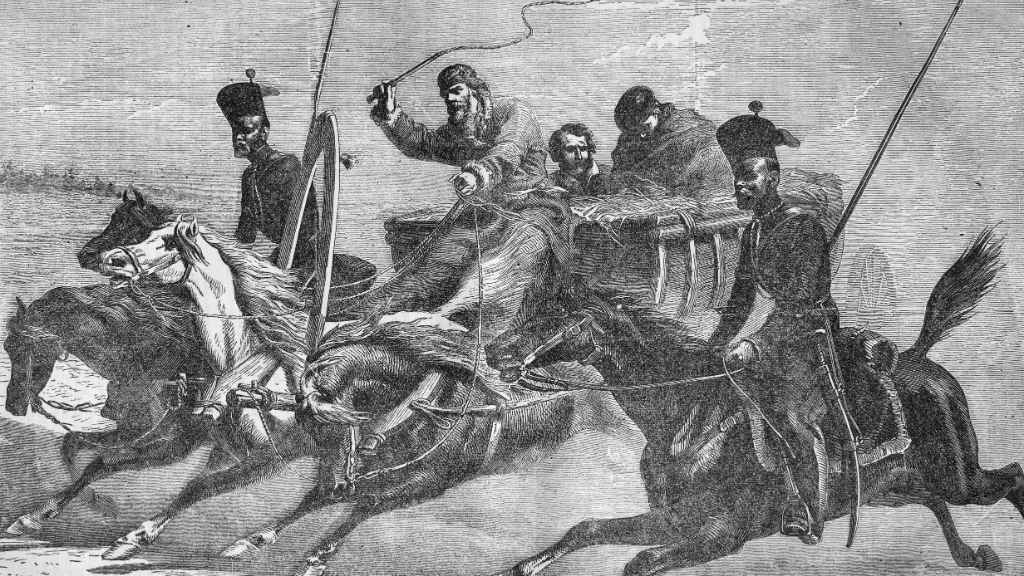
The Birth of the Modern Republic
In 1923, Mustafa Kemal Atatürk founded the Republic of Turkey, ushering in a new era of modernization. His sweeping reforms included replacing the Arabic script with the Latin alphabet, secularizing education, and encouraging Western-style dress. These changes connected Turkey with the modern world while preserving its cultural soul. The balance between tradition and progress remains one of the most fascinating aspects of Turkish culture today.
A Fusion of East and West
Modern Turkey is a living bridge between civilizations. On one side, it preserves Eastern values such as strong family ties, deep hospitality, and spirituality. On the other hand, it embraces Western modernity, seen in fashion, urban lifestyles, global media, and cutting-edge design. This cultural fusion gives Turkey its unique identity – where a centuries-old bazaar might stand blocks away from a sleek café filled with young professionals.
2. Turkish Traditions and Customs
Family Values at the Core
The family is the basis of social life in Turkish culture, extending beyond the household. Elders are highly respected, and their views are usually used to make crucial decisions. Most of the families continue to reside near each other, forming strong ties in the community. Weekend meals and special occasions are common, and usually revolve around sumptuous feasts of traditional fare. I have always found sitting at a Turkish family table more of a celebration of togetherness than a meal.
Hospitality: A Way of Life
If there’s one tradition that defines Turkey, it’s hospitality. It is not only a courtesy to give tea, coffee, or sweets to visitors, but also a sincere duty. Refusing such kindness can even be seen as impolite. I recall one time I was passing through a little town in Cappadocia: a shopkeeper insisted that I sit and have a glass of tea even though I was not purchasing anything. This small gesture is an indication of the generosity that is part of everyday life in Turkey.
Celebrations and National Holidays
Festivals bring communities together across the country. On Republic Day (October 29), cities light up with parades, concerts, and fireworks, honoring the birth of the modern nation. Religious festivals such as Eid al-Fitr (Ramazan Bayramı) are marked by visiting relatives, sharing sweets, and strengthening family bonds. These festivals indicate the combination of nationalism and spirituality that has been shaping Turkish society.
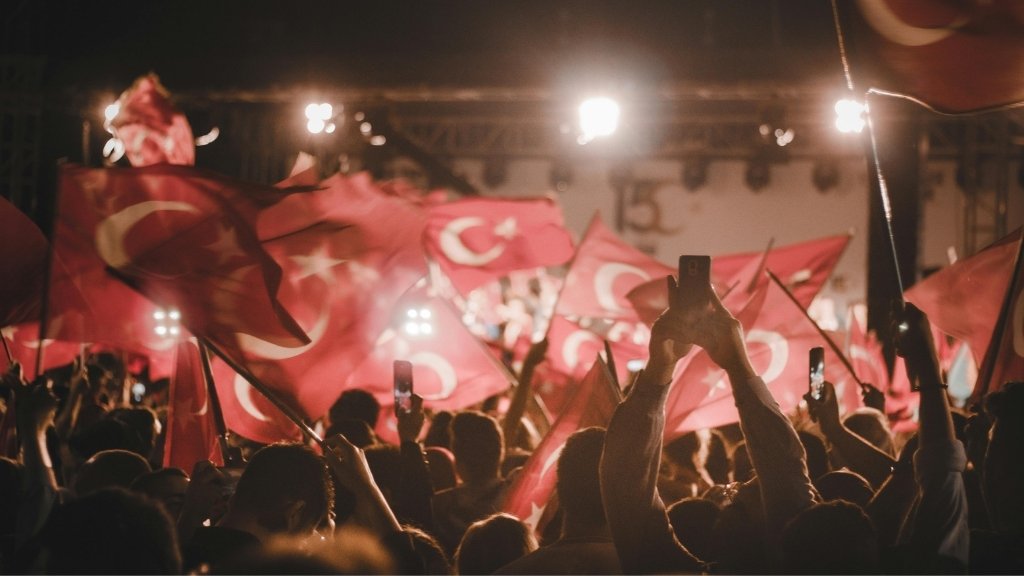
Life’s Milestones and Rituals
Major life events in Turkey carry their own cherished traditions:
- Births: Newborns are often protected with a Nazar Boncuğu (evil eye bead), believed to shield against negative energy.
- Weddings: Often lasting several days, they include lively music, traditional dances, and a henna night, where the bride’s hands are decorated in intricate patterns.
- Funerals: Marked by simple Islamic rituals, funerals emphasize community support, reminding families that grief is shared and not carried alone.
3. Turkish Language and Literature
The Origins of the Turkish Language
The story of the Turkish language reflects centuries of cultural blending. Modern Turkish evolved from Ottoman Turkish, which itself carried strong influences from Arabic and Persian due to the empire’s vast connections. In the early 20th century, Mustafa Kemal Atatürk introduced sweeping language reforms, replacing the Ottoman script with the Latin alphabet. This shift not only made reading and writing more accessible but also helped unify a rapidly modernizing nation.
Wisdom in Proverbs and Idioms
The richness of Turkish identity is often best expressed through its proverbs and idioms. These short sayings carry deep cultural wisdom and reflect values such as gratitude, patience, and respect. One well-loved example is:
“Bir kahvenin kırk yıl hatırı vardır.” – “A cup of coffee is remembered for forty years.”
This timeless phrase highlights how even the smallest act of kindness, like sharing coffee, can create bonds of friendship and loyalty that last a lifetime.
Influential Writers and Poets
Across centuries, Turkish literature has been shaped by poets and authors whose voices still resonate today:
- Yunus Emre (13th century): A mystical Sufi poet whose simple yet profound verses emphasized love, spirituality, and human unity.
- Nazım Hikmet (20th century): A revolutionary poet, celebrated for his modern style and powerful political themes, often wrote during his years in exile and imprisonment.
- Orhan Pamuk (21st century): A Nobel Prize-winning novelist, whose works such as My Name Is Red and Snow explore identity, memory, and the East-West divide in Turkish society.
Modern Literature and Global Reach
Today, Turkish literature continues to evolve, spanning epic historical novels, contemporary fiction, and works that tackle themes of migration, identity, and politics. Turkish authors are increasingly gaining recognition on the global stage, with their works translated into dozens of languages. From Istanbul’s bustling streets to the quiet villages of Anatolia, modern writers are carrying Turkey’s literary voice into the world, while staying rooted in centuries-old tradition.
4. Turkish Cuisine: A Feast for the Senses
A Culinary Mosaic of History and Culture
Turkish cuisine is one of the world’s most diverse food traditions, blending flavors from Central Asia, the Middle East, the Mediterranean, and the Balkans. What makes it unique is how recipes passed down from Ottoman palace kitchens live side by side with hearty village meals. Whether it’s fragrant rice, fresh herbs, or carefully balanced spices, Turkish food has always been about harmony, abundance, and the joy of communal dining.
The Turkish Breakfast Ritual
A Turkish breakfast (kahvaltı) is not just a meal – it’s a cultural ritual. Mornings begin with a colorful spread that often includes:
- Cheeses & Olives: A variety of local cheeses paired with black and green olives.
- Fresh Produce: Sliced tomatoes, cucumbers, and herbs straight from the garden.
- Breads & Spreads: Warm simit (sesame bread), honey, and the rich cream called kaymak.
- Endless Tea: Strong, red Turkish tea, poured into tulip-shaped glasses, keeps conversations flowing.
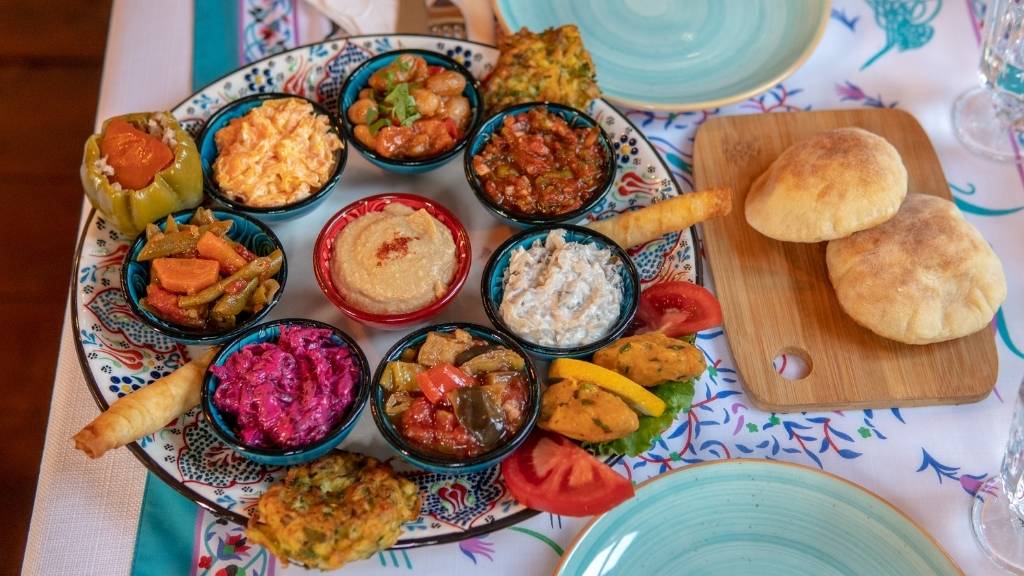
Sharing this breakfast with friends and family is one of the simplest yet most joyful experiences in Turkish life.
Iconic Dishes That Define Turkish Food
Some dishes are so deeply tied to Turkish cuisine that no trip or meal feels complete without them:
- Kebabs: From spicy Adana and mild Urfa to the indulgent İskender kebab, each region offers its own style.
- Mezes: Small, flavorful plates like hummus, smoky eggplant salads, and yogurt dips, often served with rakı.
- Pilav: Comforting rice dishes cooked with butter, spices, or chickpeas, enjoyed daily across households.
Beloved Turkish Drinks
No culinary journey in Turkey is complete without tasting its traditional drinks:
- Turkish tea (çay): Always served hot in tulip glasses, it is the nation’s daily companion.
- Turkish Apple Tea (elma çayı): A sweet, fruity herbal tea often served to visitors, symbolizing warmth and hospitality. It’s especially popular with tourists and is enjoyed both hot and cold.
- Turkish coffee: Thick, unfiltered, and strong – so iconic that UNESCO recognized it as an Intangible Cultural Heritage.
- Ayran: A refreshing yogurt-based drink, lightly salted, and perfect with grilled dishes.
Sweet Delights for Every Occasion
Turks have a special love for desserts, often shared during festivals or family gatherings:
- Baklava: Golden layers of filo pastry with pistachios or walnuts, soaked in syrup.
- Lokum (Turkish Delight): Soft, chewy cubes dusted with powdered sugar, sometimes flavored with rose or pomegranate.
- Künefe: A warm dessert made of shredded pastry filled with melting cheese, topped with pistachios.
The Vibrant Street Food Culture
Street food in Turkey is more than convenience – it’s culture on the go. From vendors selling crispy simit on every corner to stuffed mussels (midye dolma) along Istanbul’s waterfront, the variety is endless. Whether you’re grabbing a quick dürüm wrap or savoring roasted chestnuts in winter, street food offers a taste of everyday Turkish life at its most authentic.
5. Turkish Arts and Crafts
Ottoman Calligraphy and Miniature Painting
The Islamic art flourished during the Ottoman period, and calligraphy was considered the most superior art. Talented artisans used verses of the Quran to create flowing patterns that adorn mosques, manuscripts, and palaces even today. Miniature painting also thrived, depicting royal life, battles, and everyday scenes in great detail. These little works were not only beautiful but also served as a historical account of the empire’s rich past.
Turkish Carpets and Kilims
Not many crafts are as recognizable as Turkish carpets and kilims. Their pieces are known to be durable and have striking patterns, with each piece having a story behind it. Each village and region has its own weaving tradition, with symbols of love, protection, or prosperity. A handwoven Turkish carpet is a living history in your hands because the designs have been handed down through the generations.
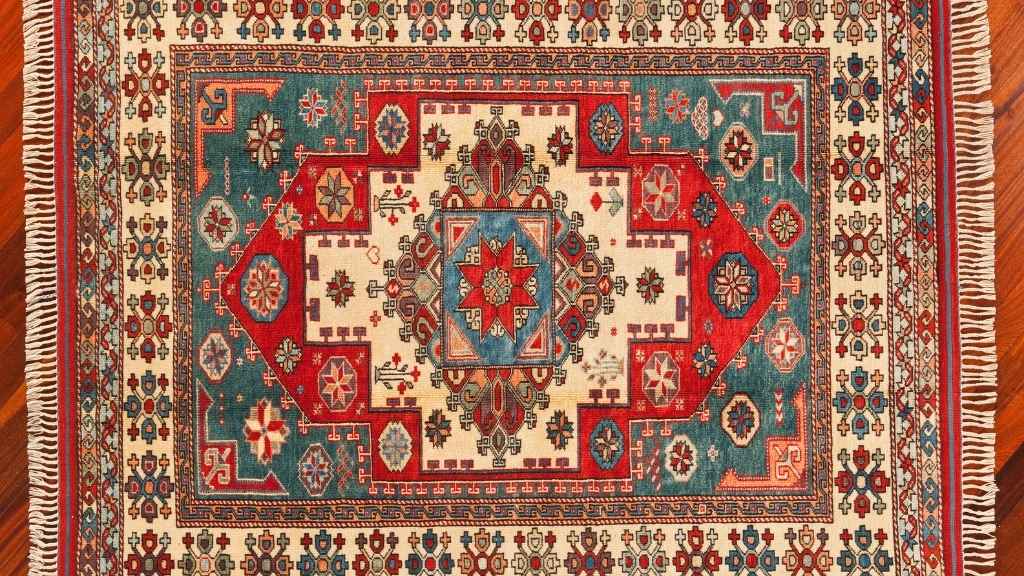
Ceramics and Pottery: Iznik Art
The town of Iznik was renowned in the 16th century due to its brilliant ceramics and pottery. Bright Iznik tiles painted in bold blues and turquoise were used to decorate Ottoman mosques, palaces, and fountains. Entering the Blue Mosque in Istanbul, you can observe thousands of these tiles, each of which is painted manually. Today, the tradition is carried on by modern artisans who combine historic techniques with contemporary designs.
Jewelry and Metalwork
Turkish jewelry and metalwork combine elegance with symbolism. Craftsmen shape silver and gold into bracelets, pendants, and amulets, often decorated with protective charms like the evil eye. These designs are not only ornamental but also deeply tied to cultural beliefs. Many families still gift such jewelry during weddings and special occasions, keeping this centuries-old craft alive.
6. Turkish Music and Dance
The Heartbeat of Turkish Music
Turkish music is incredibly diverse, blending deep-rooted traditions with modern creativity. It stretches from folk songs born in mountain villages to the refined sounds of Ottoman classical music, the spiritual tones of Sufi devotional music, and today’s thriving pop and rock scene. What ties it all together are the signature instruments: the soulful saz (bağlama), the haunting ney, the lively zurna–davul duo, and the rhythmic darbuka. Together, they shape the soundscape of Turkey’s cultural identity.
Traditional Folk Music and the Aşık Legacy
Folk music in Turkey reflects everyday life – love, migration, harvest, and heroism. Its unique flavor comes from modal systems (makam) and asymmetric rhythms like 9/8, which make Anatolian songs instantly recognizable.
Aşık tradition: Traveling poet-singers who performed with a saz, improvising heartfelt verses. Their role was more than entertainment – they were cultural storytellers, preserving history and values through music.
Instruments that Define the Sound
Every instrument carries its own story:
- Saz/Bağlama: A long-necked lute, often called the heartbeat of folk music.
- Ney: An end-blown reed flute with a breathy tone, central to Sufi music. Its sound symbolizes the soul’s longing for the divine.
- Zurna & Davul: A loud reed instrument paired with a booming drum, perfect for weddings and public celebrations.
- Kanun, Kemençe, Darbuka: Each adds melodic color or rhythmic drive, ensuring no two regions sound alike.
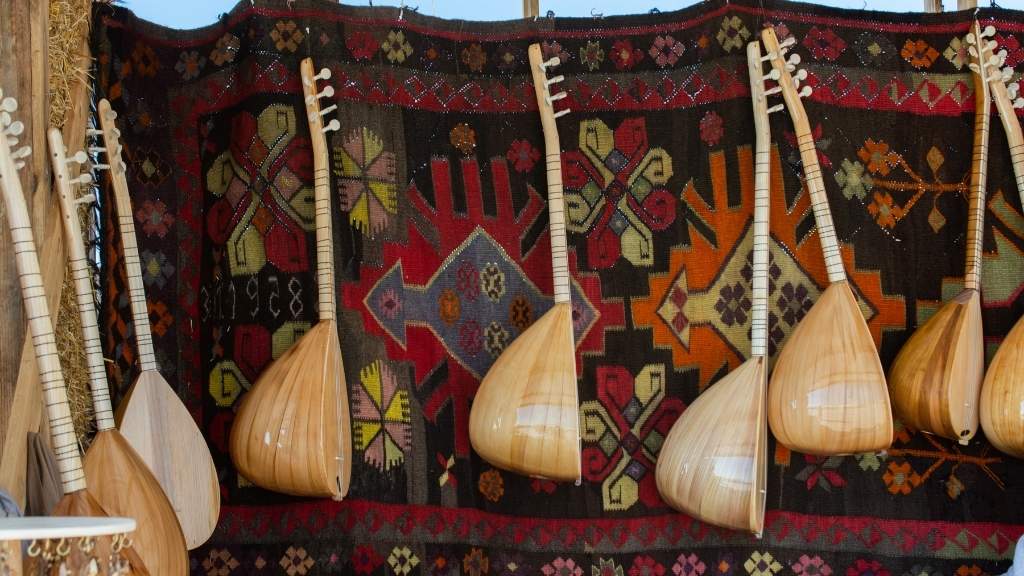
Sufi Rituals: The Whirling Dervishes
The Whirling Dervish ceremony (Sema) is one of Turkey’s most iconic spiritual practices. Accompanied by ney, frame drums, and choral hymns, dervishes spin in rhythmic devotion, aiming to achieve spiritual focus and closeness to God. The symbolism is profound – right palm turned upward to receive grace, left palm downward to share it with the world. This ritual embodies the balance between heaven and earth.
Modern Turkish Pop and Rock
Turkey’s music has not stood still. From the Anatolian rock movement of the 1960s to today’s pop and indie scenes, artists continue to blend Western influences with traditional makam-based melodies. The result is music that feels both familiar and exotic, with poetic lyrics, rich hooks, and unmistakable Middle Eastern scales layered over modern production.
Traditional Dances Across Regions
Music in Turkey is inseparable from dance, each region showcasing its own unique style:
- Halay (Central/East): A communal line dance with strong energy, led by the pounding davul–zurna.
- Zeybek (Aegean): A heroic solo or group dance with wide, commanding postures.
- Horon (Black Sea): Fast, synchronized footwork, often performed to the sharp sounds of the kemençe.
- Kaşık Oyunu (Mediterranean): Dancers click wooden spoons in rhythm, turning everyday tools into instruments of joy.
7. Turkish Clothing and Fashion
From Tradition to Modern Trends
Turkish clothing reflects a fascinating mix of history, faith, and style. From the rich layers of Ottoman ceremonial wear to today’s innovative Turkish fashion industry, dress in Turkey has always carried meaning beyond fabric. In cities like Istanbul, you’ll find international trends alongside modest fashion. At the same time, in rural areas, regional costumes still honor centuries-old traditions.
Ottoman Elegance: Kaftans and Entari
During the Ottoman Empire, clothing was not only about beauty but also status.
- Kaftan & Entari: Made from silk and velvet, these long robes were decorated with ornate embroidery and metallic threadwork. They were worn by sultans, courtiers, and wealthy families.
- Şalvar: Loose, wide trousers, common among both men and women, offered comfort and practicality. Even today, you can still spot şalvar in village life, especially during festivals and cultural events.
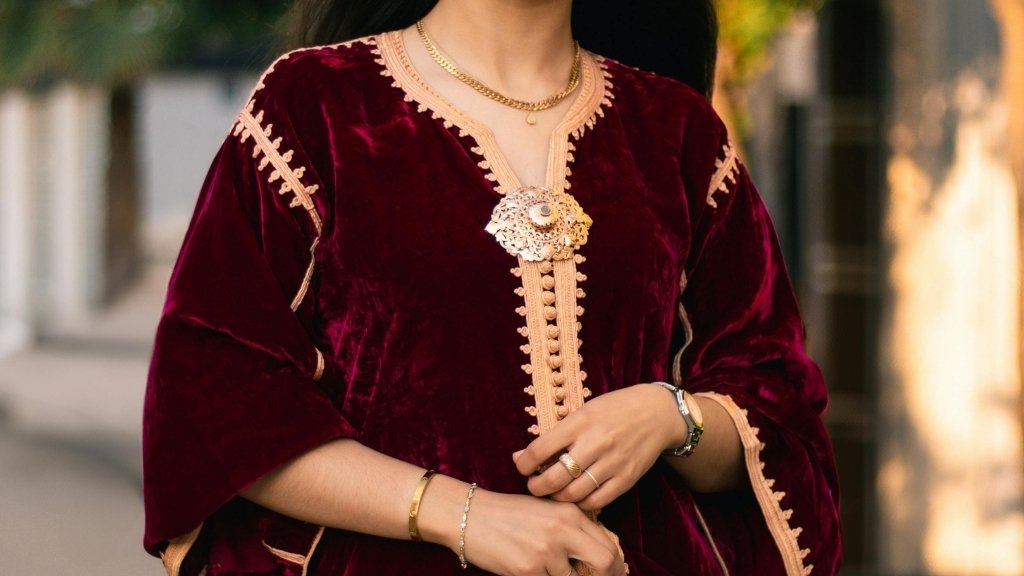
Regional Costumes and Their Meanings
Each part of Turkey developed its own folk costumes, often signaling a person’s region, marital status, or the type of celebration.
- Black Sea: Known for colorful vests and pleated skirts, often paired with lively dances like the horon.
- Southeast Turkey: Women’s attire includes richly decorated headpieces and coin-embroidered scarves, symbolizing prosperity and heritage.
These costumes remain an essential part of weddings, harvest festivals, and cultural performances.
Istanbul’s Growing Fashion Scene
Today, Istanbul has emerged as a hub for the modern Turkish fashion industry, blending European tailoring with Anatolian fabrics and designs. Key trends include:
- Modest Fashion: Turkey is a global leader in this market, with creative takes on the headscarf and modest wear.
- Sustainable Textiles: Local designers are reintroducing handwoven fabrics, organic cotton, and eco-conscious production.
- Artisan Collaborations: Crafts such as embroidery, carpet weaving, and leatherwork inspire runway collections, keeping traditions alive in modern forms.
The Role of Headscarves and Modest Style
The headscarf (türban) remains one of the most recognizable pieces of Turkish clothing. Styles vary by region and personal belief – from luxurious silk prints in urban settings to simple cotton wraps in rural areas. For religious observers, it symbolizes modesty; for others, it can be a cultural or fashion choice.
💡Travel Tip: When visiting mosques, women are expected to cover their heads. Carrying a light scarf is a respectful and practical way to blend in.
8. Religion and Beliefs in Turkey
Religion in Turkey is a blend of Islam, secularism, and deep cultural heritage. While most Turks identify as Muslim – with visible Sufi traditions and Alevi practices – daily life is shaped by both faith and modern secular values. What makes it fascinating is how these layers coexist, sometimes even within the same family.
Islam and Everyday Life
Islam plays a central role in shaping Turkey’s culture. You’ll notice:
- Prayer Times: Daily rhythms often align with the call to prayer.
- Hospitality & Charity: Welcoming guests, helping neighbors, and respecting elders are seen as acts of faith.
- Halal Dining: From street kebabs to luxury restaurants, halal food is featured on menus and celebrated in various settings.
Personally, I’ve found that even in busy Istanbul, families still pause during iftar in Ramadan to share meals with neighbors, showing how faith ties directly to community.
Religious Festivals: Ramadan and Eid
Two of the most important celebrations are:
- Ramadan (Ramazan): A month of fasting, nightly iftar meals, and special prayers. Streets come alive with lanterns, markets, and family gatherings.
- Eid al-Fitr & Eid al-Adha: Times for charity, visiting relatives, exchanging gifts, and sharing traditional dishes. These holidays are as much about togetherness as they are about faith.
Minority Religions and Heritage
Turkey also protects a rich mosaic of Greek Orthodox, Armenian Apostolic, and Jewish communities, especially in cities like Istanbul and Izmir. Their churches, synagogues, and holidays remain part of Turkey’s living cultural identity. Walking through Istanbul’s Fener or Balat districts, you can still hear church bells alongside the call to prayer.
Secularism and Modern Beliefs
Since the Republic’s founding, secular governance has been a cornerstone of public life. Yet, personal beliefs vary widely – from devoutly observant households to strongly secular ones. It’s common to see siblings or cousins with different lifestyles, reflecting Turkey’s unique balance of faith and freedom.
💡Quick Answer: Is Turkey secular or religious? → It’s both. The balance depends on the region, family, and personal choice, making Turkey one of the most diverse cultural landscapes in the world.
9. Turkish Architecture
A Blend of Heritage and Modern Skylines
Turkish architecture is a living timeline of civilizations, where Byzantine domes, Seljuk stonework, and Ottoman mosques stand side by side with modern skyscrapers. From the spiritual awe of Hagia Sophia to Istanbul’s glass towers overlooking the Bosphorus, the country’s buildings reflect both its layered history and its vision of the future.
Byzantine Foundations: Hagia Sophia
The most iconic landmark of Byzantine heritage is the Hagia Sophia. Built in the 6th century, its soaring dome and shimmering mosaics changed the course of world architecture. Later, it inspired the design of countless Ottoman mosques, proving how cultural exchange shaped Turkey’s architectural identity. Walking inside today, visitors feel both the weight of history and the artistry of timeless engineering.
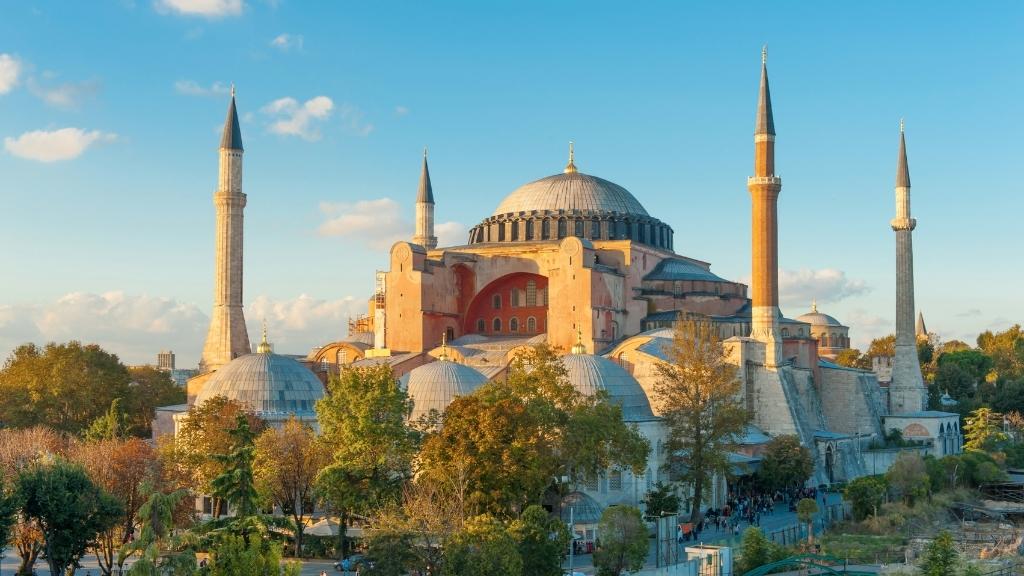
Hagia Sophia – a historical and cultural landmark in Istanbul.
Ottoman and Seljuk Masterpieces
The Ottoman golden age, led by architect Mimar Sinan, produced mosques such as Süleymaniye and Selimiye, where central domes symbolized unity and divine order. Palaces like Topkapı reveal another side of Ottoman life, with tiled courtyards, private gardens, and hidden treasuries.
Even earlier, the Seljuks left their mark on Anatolia with sturdy caravanserais, intricate madrasas, and stone portals along Silk Road trade routes. Their geometric ornamentation and monumental gateways remain striking reminders of medieval craftsmanship.
Modern Skylines with Historic Roots
Today, Turkey’s cities showcase a striking contrast: glass towers rising alongside preserved Ottoman mansions, caravanserais turned into boutique hotels, and museums housed in restored hans. Bridges like those spanning the Bosphorus reflect modern engineering ambition. At the same time, adaptive reuse projects ensure cultural heritage remains relevant in daily urban life. This balance of preservation and innovation makes modern Turkish architecture a bridge between past and present.
10. Turkish Lifestyle and Daily Life
Family, Food, and Social Traditions
The heart of the Turkish lifestyle is built around strong family bonds, shared meals, and vibrant community spaces. Daily life often flows between tea gardens, coffeehouses, neighborhood markets, and cherished traditions, such as the hammam. Even in busy cities, these cultural rituals keep people connected to their heritage.
👉If you’re especially interested in how these values shape families, I recommend exploring Family Life in Turkey: Inside Traditions and Values, which takes a closer look at how traditions, respect, and modern changes influence everyday life at home.
Tea Gardens and Coffeehouses
- Tea Gardens (Çay Bahçesi): More than just a place to drink tea, these gardens are where friends gather for conversation, laughter, and a round of backgammon. Whether in a seaside town or tucked away in a city square, the çay bahçesi is a symbol of community life.
- Coffeehouses (Kıraathane): Once known as reading rooms, coffeehouses have evolved into lively hubs where locals share news, play games, and connect. A glass of tea or strong Turkish coffee often fuels hours of discussion.
The Hammam Ritual
A visit to a Turkish bath (hammam) is both a wellness tradition and a cultural experience. The sequence – steam, exfoliation with a kese (scrub mitt), and a foam massage – offers deep relaxation while also fostering social bonds. Many locals still enjoy this ritual weekly, and visitors often find it to be a unique way to connect with Turkish culture.
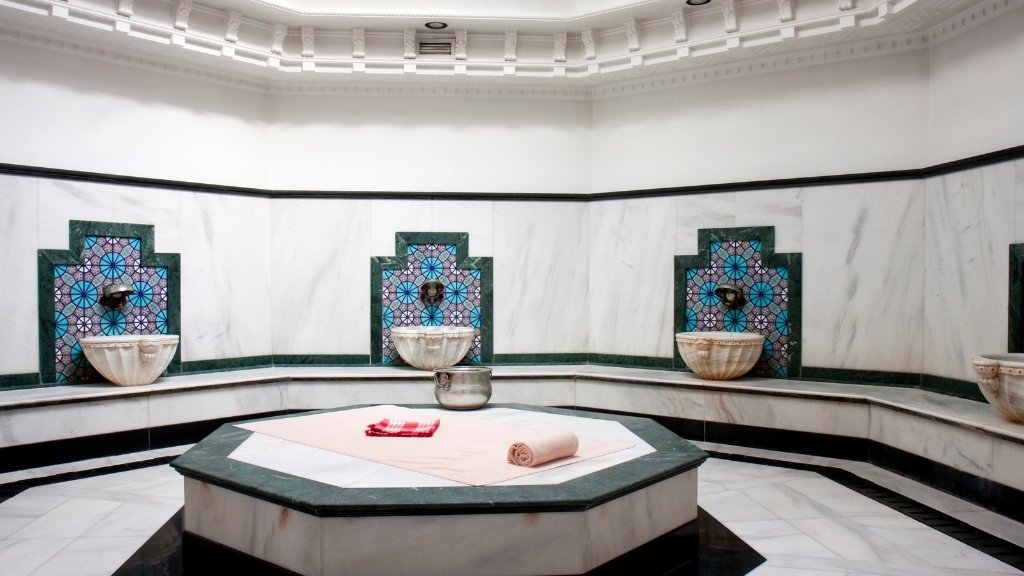
Turkish Hammam.
Tip: Always bring modest swimwear and check whether the hammam has mixed or gender-specific hours.
Leisure and Social Gatherings
In the evenings, many Turks enjoy a stroll (gezmek), sipping tea by the sea or indulging in sweets at a dessert café. Weekends are often dedicated to family lunches, countryside picnics, or visiting grandparents. These moments highlight the value placed on togetherness and hospitality in Turkish daily life.
Sports and Outdoor Adventures
Sports are another cornerstone of life in Turkey. Football is the national passion, while basketball and volleyball continue to gain popularity. For outdoor enthusiasts, the country offers endless adventures – hiking in Cappadocia, paragliding over Ölüdeniz, trekking through the lush Black Sea mountains, or sailing along the turquoise Aegean coast.
11. Turkish Festivals and Celebrations
National Holidays that Unite the Nation
Turkish festivals reflect both the country’s modern republic identity and its deep cultural traditions. Every year, state holidays are celebrated with great pride, often blending parades, concerts, and community gatherings. For example, National Sovereignty and Children’s Day (April 23) marks the founding of parliament and is dedicated to children’s rights. Schools organize performances, colorful parades, and cultural shows, making it one of the most joyful days in Turkish celebrations.
Republic Day and Victory Day
Two of the most important national holidays are Republic Day (October 29) and Victory Day (August 30).
- Victory Day: Celebrated with military parades, air shows, and wreath-laying ceremonies, honoring Turkey’s military history.
- Republic Day: Cities light up with fireworks, concerts, and illuminated bridges over the Bosphorus, reflecting the spirit of unity and progress.
Cultural and Seasonal Festivals
Not all celebrations are about politics – many highlight Turkey’s nature and traditions. The Istanbul Tulip Festival each spring transforms city parks into seas of color, echoing the Ottoman tulip era when the flower symbolized beauty and wealth. These blooms attract both locals and tourists, making April a favorite month to visit Istanbul.
Folk and Sporting Traditions
Some of the most unique Turkish festivals come from centuries-old folk traditions:
- Camel Wrestling (Aegean Region): A heritage spectacle where decorated camels “wrestle” in a controlled manner, accompanied by music, folk dances, and local food stalls.
- Oil Wrestling (Kırkpınar): Known as the world’s oldest continuous sporting event, wrestlers cover themselves in olive oil before competing in this traditional sport that blends strength, endurance, and ritual.
💡Tip: While camel wrestling is carefully regulated, welfare practices can differ. If attending, it’s best to check local guidelines to ensure ethical standards are followed.
12. Turkish Cinema and Television
From Yeşilçam to Modern Storytelling
Turkish cinema has come a long way since the days of the Yeşilçam studio era, often compared to Hollywood’s Golden Age. Back then, melodramas, comedies, and love stories dominated the screen, shaping the cultural memory of generations. As the industry matured, filmmakers began experimenting with realism, producing films that reflected everyday struggles, social change, and rural-urban contrasts.
International Recognition of Turkish Films
Today, Turkish films are celebrated in international festivals for their unique blend of atmospheric storytelling and thought-provoking themes. Directors like Nuri Bilge Ceylan have earned global recognition for their “slow cinema” style – characterized by long silences, moral ambiguity, and breathtaking landscapes. These films often explore the tension between tradition and modernity, making them relatable far beyond Turkey’s borders.
Global Success of Turkish TV Dramas
If cinema built the foundation, Turkish television dramas (diziler) took the culture worldwide. Known for their long-form storytelling filled with romance, betrayal, and family intrigue, these series have become global hits across Latin America, the Middle East, and even South Asia. Beyond entertainment, diziler have boosted interest in Turkish culture, tourism, and even the Turkish language, as international audiences grow fascinated with the country’s way of life.
Spotlight on Stars and Creators
A major reason behind this success lies in the talent of Turkish actors and directors. Figures such as Halit Ergenç (from Magnificent Century) and Beren Saat (Fatmagül) have become household names abroad. Meanwhile, acclaimed directors continue to bring Turkish storytelling to the global stage, ensuring that both cinema and television remain powerful cultural exports.
13. Turkish Education and Intellectual Life
From Ottoman Madrasas to Modern Learning
The roots of Turkish education stretch back to the Ottoman Empire, when knowledge was passed down in madrasas – religious schools often attached to mosques. These institutions emphasized Islamic law, theology, literature, and the sciences, reflecting the values of the era. While the system was deeply traditional, it laid the groundwork for Turkey’s later transformation into a modern, secular education model.
Building a Modern Education System
Today, Turkey has a secular and structured education system shaped by sweeping reforms in the early 20th century, including the famous alphabet reform that replaced Ottoman Turkish with the Latin script. Schooling is now compulsory for children, with a mix of public and private schools serving the country’s youthful population. Students typically progress through primary, secondary, and high school before moving into universities or vocational programs.
Quick breakdown of the system:
- Primary Education (ages 6–10): Focus on literacy, math, and basic sciences.
- Middle School (ages 11–13): Expanded curriculum with history, foreign languages, and cultural studies.
- High School (ages 14–17): Divided into general, technical, and vocational tracks to prepare students for university or career.
Universities and Research Hubs
Turkey’s universities and research centers are among the most dynamic in the region. Leading institutions like Istanbul University, Middle East Technical University (METU), and Ankara University are known for excellence in engineering, medicine, archaeology, and social sciences. International collaborations and growing investment in higher education have also turned Turkey into a hub for students from surrounding countries.
Contributions to Science, Arts, and Global Knowledge
Turkish scholars and researchers have made remarkable contributions in fields such as archaeology, linguistics, materials science, and digital media. Excavations in Anatolia have shaped global understanding of ancient civilizations. At the same time, modern Turkish scientists and diaspora scholars continue to influence everything from AI research to medical innovation. This blend of tradition and modernity positions Turkey as a bridge between Eastern and Western intellectual life.
14. Turkish People and Identity
The Turkish identity is far from one-dimensional. Each region has its own cultural flavor, shaped by geography, history, and daily life. On the Aegean and Mediterranean coasts, you’ll find a more cosmopolitan lifestyle, influenced by centuries of trade and seafaring. In contrast, the Black Sea region is famous for its strong sense of community, seafaring traditions, and lively folk dances like the horon, which reflect the region’s fast rhythms and energetic spirit. Moving inland, Central and Eastern Anatolia highlight Turkey’s agrarian roots, with conservative customs in some areas, alongside vibrant folk arts and storytelling traditions that have been passed down for generations.
The Turkish Diaspora and Global Influence
Millions of Turkish people abroad, especially in Europe, play a vital role in shaping and spreading culture worldwide. From Berlin’s bustling Turkish markets to Turkish restaurants in London or Amsterdam, diaspora communities have exported their cuisine, music, and even fashion. At the same time, this global presence creates a two-way exchange – blending Turkish traditions with local cultures and enriching both. Many second-generation Turks proudly balance dual identities, maintaining ties to their heritage while embracing modern life abroad.
Pride in Heritage and Traditions
Despite regional and global differences, one unifying thread is the pride the Turkish people take in their heritage. Family remains at the heart of social life, with deep respect for elders and a strong emphasis on hospitality. National holidays, religious festivals, and local traditions continue to bring communities together across generations. Something as simple as learning a few Turkish phrases – like “teşekkür ederim” (thank you) – can go a long way in showing respect and being warmly welcomed.
Blending Tradition with Modern Aspirations
One of the most fascinating aspects of Turkish identity is how easily it balances the old with the new. In many households, you might see traditional ceremonies like a henna night before a wedding, followed by a modern reception filled with live music and digital-first touches such as drone videography or Instagram-worthy décor. This seamless blending of tradition and modernity reflects Turkey’s position as a cultural bridge between East and West. And when people ask, “Is Turkish culture Eastern or Western?” – the best answer is both. That unique fusion is exactly what makes it so distinctive.
15. Tourism and Cultural Attractions
Istanbul: A Living Cultural Capital
When it comes to tourism in Turkey, all roads lead to Istanbul. This city blends empires and modern life in a way few places on earth can. A day might start with the call to prayer echoing from the Blue Mosque, continue with haggling over spices in the Grand Bazaar, and end with a sunset ferry ride across the Bosphorus. For art lovers, the city also boasts world-class galleries and contemporary museums that highlight Turkey’s evolving creative scene.
- Top landmarks: Hagia Sophia, Topkapı Palace, Blue Mosque
- Local experience: Sip strong Turkish tea in a garden overlooking the Golden Horn
Cappadocia and the Heritage of Anatolia
Few places capture the imagination like Cappadocia, with its fairy chimneys, cave dwellings, and centuries-old churches carved into the rock. A sunrise hot-air balloon ride is the highlight for many travelers, offering a bird’s-eye view of the unique volcanic landscape. Beyond Cappadocia, the wider region of Anatolia carries the legacy of the Silk Road and early Christian history, making it a must for cultural travelers.

Cappadocia hot-air balloons – a highlight for many travelers.
Coastal Cities and Mediterranean Charm
Turkey’s coastline stretches along both the Aegean and the Mediterranean, offering everything from bustling seaside resorts to quiet olive groves. Cities like Antalya, Bodrum, and İzmir combine turquoise beaches with layers of history, including nearby ruins such as Ephesus and Pergamon. Whether you’re enjoying yacht marinas, dining on fresh seafood, or wandering through old town bazaars, these destinations perfectly capture Mediterranean culture.
Travel tip: At religious or historic sites, modest dress is appreciated, and always ask before photographing locals.
Museums and UNESCO World Heritage Sites
For history enthusiasts, Turkey is nothing short of an open-air museum. UNESCO sites like Göreme National Park, Hierapolis-Pamukkale, and the historic town of Safranbolu showcase civilizations spanning thousands of years. In Istanbul alone, you can visit treasures like Hagia Sophia and Topkapı Palace, each telling a different story of the city’s layered past. These landmarks remind visitors why Turkey is often called a bridge between East and West.
16. The Future of Turkish Culture
Global Influence Beyond Borders
The future of Turkish culture is already being shaped by its growing global influence. Turkish TV dramas, known as dizis, are watched by millions across Latin America, the Middle East, and even South Asia, often sparking tourism to filming locations in Istanbul or Cappadocia. Beyond the screen, Turkish cuisine, design, and music have become powerful tools of cultural diplomacy – introducing new audiences to Turkey’s heritage and inspiring many to learn the Turkish language.
The Expanding Role of Turkish Media
Modern Turkish media is no longer confined to national borders. Streaming platforms such as Netflix and Disney+ have boosted the international reach of Turkish shows, while co-productions with other countries are diversifying themes and storylines. This wider distribution not only boosts Turkey’s image abroad but also strengthens its cultural soft power in shaping how the world perceives Turkish identity.
Youth, Innovation, and Modern Trends
Turkey’s younger generations are blending tradition with innovation. From startups and esports to street fashion and eco-conscious brands, Turkish youth culture is becoming both entrepreneurial and globally minded. Yet, these trends often stay rooted in heritage – modern designers, for example, weave traditional motifs into contemporary clothing lines. For brands and bloggers, the lesson is clear: authentic cultural storytelling paired with modern digital visuals captures strong engagement online.
Preserving Heritage in a Fast-Changing World
Even as Turkey modernizes, heritage preservation remains a national priority. Initiatives such as sustainable tourism projects, craft cooperatives, and digitized cultural archives ensure that traditions – ranging from carpet weaving to Ottoman architecture – are not lost. Instead, they’re being reimagined for today’s world, allowing Turkey to embrace change while honoring its timeless roots.
Final Thoughts
Turkish culture is not frozen in the past – it’s a living bridge between East and West, blending Byzantine art, Ottoman elegance, Sufi music, and modern creativity into everyday life. From the aroma of Turkish cuisine to the warmth of local hospitality, every encounter feels like being welcomed into a family. What makes it unforgettable is how tradition and progress walk side by side, shaping a culture that is both timeless and globally influential.
If you’ve enjoyed this journey into Turkey’s traditions, stories, and lifestyle, stay connected. 👉 Subscribe below for more in-depth guides, festival highlights, and travel tips designed to help you experience Turkish culture in its richest form.
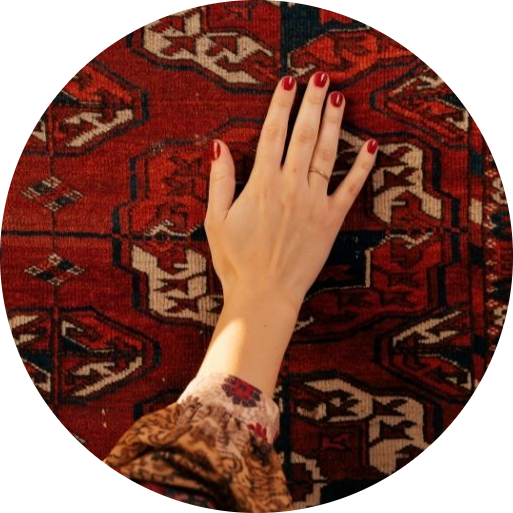
Hi, I’m the heart behind Turkish Aura. I lived in Turkey for 10 beautiful years, where I fell in love with its tea, traditions, and soulful way of life. This blog is my way of sharing real stories, cultural wisdom, and personal experiences to help you feel the true essence of Turkish culture – just like I did.Thank you for being here, and love you!

